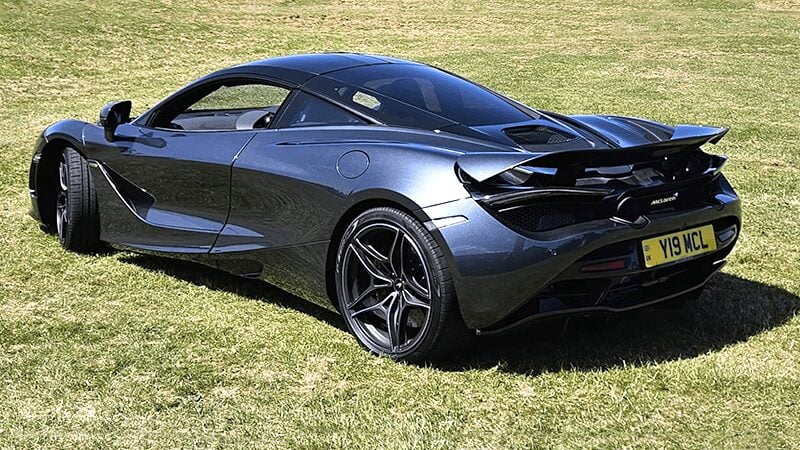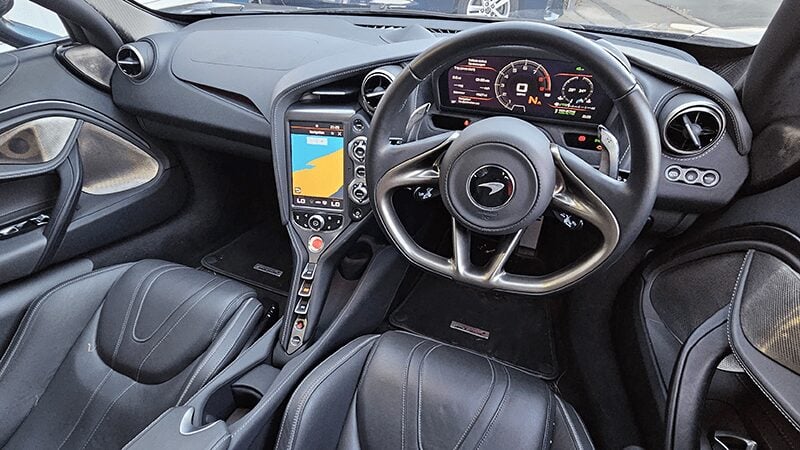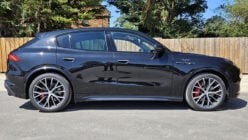
It’s actually pretty amazing to think that the 720S was only the McLaren brand’s fourth car since it was founded in 2010. That’s right, the F1 was technically made by a different company (although under the same ownership).
The first was the MP4-12C, which became the 12C and subsequently evolved into the 650S. Then came the P1, retconned as the first “Ultimate Series” model, before the entry level “Sports Series” 570S line was spun off with a second-gen version of the MonoCell platform.
720S followed in 2017, with the all-new MonoCage platform, effectively launching the “Super Series” that complete the three-pronged line-up used by McLaren until relatively recently.
It’s also the oldest model in McLaren’s line-up and is, accordingly, being retired throughout this year to be replaced with the 750S – and we thought it’d be a good chance to say goodbye to a car we’ve had some good times with and driven a few times in the past.
What Makes it Go?
Actually the same thing as has powered every McLaren to date (in various forms) until the introduction of the Artura last year – and it has quite an interesting origin.
It’s a twin-turbo V8 unit which, in this application, is branded M840T. That’s the same engine you’ll find in the Speedtail (turned up a bit) and the basis for the 840TR in the back of the McLaren Senna. While badged as “McLaren”, it’s actually developed by McLaren and race engine manufacturer Ricardo and based on the Nissan VRH engine used in endurance racing back in the 1980s and 1990s – similar to the one found in the R390 GT1 race car.
Slightly sanitised for road use (and 10,000mi service intervals), the four-litre V8 kicks out a maximum of 710hp – or 720PS in the awful quasi-metric units so beloved of car brands these days and the source of its name – all to the rear wheels alone. There’s also 568lbft of torque, available from as little as 2000rpm. There’s no hybrid tech here, and in fact the 750S won’t have any either.
On a dry road – because doing it in the wet is insane – 60mph will come up in less than three seconds (and 100mph in under eight, assuming the road is a track). Top speed is 212mph, which we’ve obviously not tested but don’t feel any need to question; the 720S is very, very fast.
Officially the combined fuel economy is 23.2mpg (Imp) but in our experience that’s quite pessimistic, especially if you’re doing 70mph motorway miles where we got pretty close to 30mpg (Imp) – although heavy-footedness will reduce that to single digits on the instant readout… A big, 15.8 gallon tank means a range of 366 miles and that’s absolutely achieveable, if you behave.

What’s it Like to Drive?
I’m not going to focus here on the car’s limits. If you reach them, on the public road, you have to be driving so badly, so violently, and so ham-fistedly that you shouldn’t be let loose with anything more dangerous than a mechanical pencil-sharpener. Or you’ve got it in Track mode in the wet, which is pretty much the same thing.
It’s unlikely that anyone without significant track experience and time in this car and its rivals can tell you which is best, and in any case only about three of these will ever be driven in anger on a circuit. Suffice to say it has such an enormous performance envelope that really any discussion of how it performs on the road is pretty moot. It’s extremely fast, everywhere, even in Comfort and Sport modes, and you don’t need and can’t exploit anything more than this can offer.
The real party piece of the 720S is just how well-behaved it is at all times, and that’s down to two things. Firstly, McLaren road tests all of its cars here in the UK. That might not mean a lot to non-UK residents, but our roads suffer from chronic underinvestment; we’ve been to Woking, and the roads are poor – and I grew up six miles from the new MCTC construction facility near Sheffield, where they’re worse.
With suspension tuned for this type of rubbish surface, the 720S is exactly as good as you’d think it would be bad on rough ground. We’re not talking Rolls-Royce or even Citroen levels of smooth, but it’s better than a Fiesta ST. Okay, that’s not a high benchmark… so let’s say it’s about equal to an Alpine A110.
Just as important is McLaren’s rather archaic use of an electro-hydraulic steering rack. The steering feels precise and neat, with very little “bad” feedback from sketchy surfaces but plenty of “good” feedback. It’s such a nimble car and an absolute joy to drive at pretty much any speed.
Pretty much. Very low-speed stuff is a bit of a challenge, with the combination of visibility, relatively low steering angles (and high caster as you turn), rather unwilling carbon-ceramic brakes, and a lot of power waiting to punch you in the spine making it a little tricky to wrangle around a car park. And the engine gets hot quick if you’re not moving at road speed. That said, it has a very accurate radar system and the parking camera now appears in the binnacle, and along with the nose lift it’s really just a matter of learning where the edges are. Although these are all optional extras…

And on the Inside?
The inside really starts with the outside and those hilarious butterfly (okay, “dihedral”) doors which swing up and out in the most beautifully damped fashion. They are literally fingertip light in either direction.
Once you have posted yourself into the hole – having hurdled nearly a foot of sill – you’re into a very nicely appointed environment indeed. It is, of course, just a two-seater, with a whole lot of engine behind the rear cabin bulkhead, but you’re not exactly crammed in. There’s decent shoulder-, elbow-, and hip-room for both occupants and it’s very easy to use the seat adjusters (once you’ve worked out where they are) and steering wheel adjuster to get a great driving position.
It has to be said that there’s really not a lot of storage space for bits and bobs in the cabin. You don’t get a glovebox, for example, and there’s only a very shallow covered tray in the centre console suited to a pair of sunglasses. There’s a little more ahead of the flying buttress with the drive controls on it, but again it’s quite narrow and shallow and you might find items pinging out of it if you’re not carefull.
That said, there is a storage shelf atop the engine cover behind you, with elasticated straps, but don’t put anything that melts easily on it. The froot/frunk is actually pretty generous at 20 litres more than you get in the back of an MX-5. Officially the combined luggage space is 360 litres – hatchback volume – but that’s split between the shelf and the froot.
Whether you’ve waved the MSO stick over the interior or not – such as our orange seatbelts, at a £300 cost – it’s a really nice place to be and really well screwed together. It passes the poke test too, with little evidence that all the materials are just skin deep. That said, the drive mode dials do still look and feel a bit like something from a mid-market console steering peripheral, and the drive/neutral/reverse selector looks like it’s come from a mid-80s Yamaha electric organ.
Following the… and I’ll be kind… atrocious early attempts at an infotainment system from McLaren, the current version is actually pretty good. It’s still a little bit “unique” to use, but once you’ve learned its little foibles it’s not hard to use. McLaren has also shifted the parking camera display from this eight-inch portrait screen to the instrument binnacle – which is excellent, if sometimes a bit hard to see with big steering angles. I should also add that the entire binnacle – as with all 720S models – folds away into a “focus” mode, giving you only the basic information you need while driving.

How Much Does it Cost?
Are you sitting comfortably? The 720S with no options will set you back £222,800 – or $310,500 in the US market if you could still get them. Our test car has more than a few optional extras from the MSO branch, totalling £49,210 for an on-the-road cost of £272,010.
What are the Main Rivals?
Pick a supercar, any supercar.
Obviously the main alternative to anything mid-engined and 200mph+ capable is Italian, and specifically from Maranello. The Ferrari F8 Tributo actually works out as a little less expensive than the 720S, matching it for power and performance figures. Lamborghini’s Huracan undercuts both (by some distance for the slower RWD model), as does the Audi R8 on which it’s based. One tasty newcomer to the scene is the Maserati MC20, with a similar price and performance.
Alternatively… a house, I guess?

What’s the Verdict?
In the real world, the 720S only has two issues, with question marks over its reliability record and the rate at which it depreciates. As someone who doesn’t have to own one, and has driven a lot of them to date (along with its siblings), I’ve never encountered either problem.
What I have encountered is a superlative performance car that is no harder to deal with on a day-to-day basis than a Mazda MX-5. They even have similar luggage space, only it’s in the McLaren’s nose. I’m still not a massive fan of how it sounds in the cabin in the comfort drive modes (remedied by flicking it into Sport) and some of the controls are still a bit idiosyncratic, but it’s really, really hard to beat as a general experience.
It’s only slightly more challenging to drive on the UK’s awful roads and tight corners than a hot hatchback, and that’s only due to visibility and width. Climbing in and out through those hilarious doors, and what it can do when prodded, will never, ever get old.



